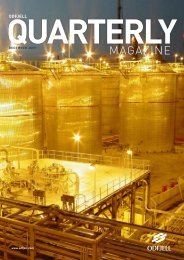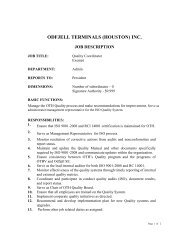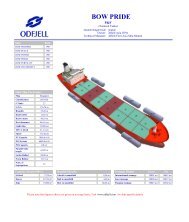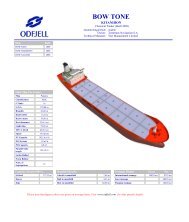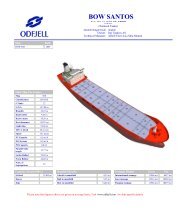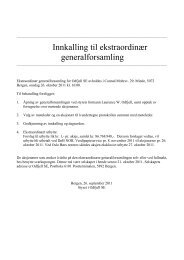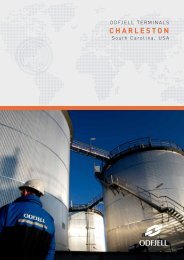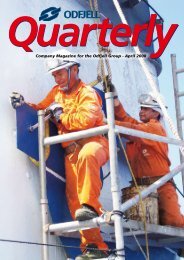Odfjell SE Annual Report 2012
Odfjell SE Annual Report 2012
Odfjell SE Annual Report 2012
Create successful ePaper yourself
Turn your PDF publications into a flip-book with our unique Google optimized e-Paper software.
odfjell group<br />
Note 4 Financial Risk<br />
management<br />
<strong>Odfjell</strong>’s results and cash flow are influenced<br />
by a number of variable factors. Our policy<br />
is to manage the risks we are exposed to,<br />
including, but not limited to market risk,<br />
credit risk, liquidity risk, currency risk<br />
and interest rate risk. Our strategy is to<br />
systematically monitor and understand the<br />
impact of changing market conditions on<br />
our results and cash flow and to initiate<br />
mitigating actions where required.<br />
Financial risk management is carried out by<br />
a central treasury function. Various financial<br />
instruments are used to reduce fluctuations<br />
in results and cash flow caused by volatility<br />
in exchange rates, interest rates and bunker<br />
prices.<br />
The below table show sensitivity on the<br />
Group’s pre-tax profit and equity due to<br />
changes in major cost components on yearly<br />
basis (calculation based on best estimates):<br />
Cost component Equity Net Result<br />
Bunkers,<br />
USD 10 per tonne<br />
higher 1.2 mill. (5.4 mill.)<br />
Interest rates,<br />
1% higher 3.2 mill. (10 mill.)<br />
Currency,<br />
USD 10% lower 2.2 mill. (11 mill.)<br />
Credit risk<br />
Multiple counterparts are used to hedge our<br />
risk. We primarily use our lending banks as<br />
counterparts to enter into hedging derivatives.<br />
From time to time other counterparties<br />
may be selected. We deem all to be high quality<br />
counterparts. In addition, the Company’s<br />
hedging policy establishes maximum limits<br />
for each counterparty. The Group therefore<br />
regards its maximum risk exposure as being<br />
the carrying amount of trade receivables<br />
and other current receivables (see note 29).<br />
The Group has given guarantees for third<br />
parties’ liabilities as shown in note 16.<br />
Liquidity risk<br />
The Group’s strategy is to have enough liquid<br />
assets or available credit lines to, at any<br />
time, to be sufficiently robust to withstand<br />
prolonged adverse conditions in the markets<br />
where we operate. Surplus liquidity is mainly<br />
invested in bonds with low risk.<br />
See also note 5, 7, 29 and 30 for aging analysis<br />
and currency exposure.<br />
Currency risk<br />
The Group enters into currency contracts to<br />
reduce currency risk in cash flows denominated<br />
in non-USD currencies. Investments in<br />
associated companies and subsidiaries with<br />
a non-USD currency as functional currency<br />
are generally not hedged. Such investments<br />
generate foreign currency translation differences<br />
that are booked directly to other<br />
comprehensive income, see Statement of<br />
other comprehensive income.<br />
The Group has certain assets and liabilities<br />
denominated in NOK that are not fully hedged.<br />
Fluctuations in the USD/NOK exchange rate<br />
will influence the Group’s profit. The most<br />
material items are Tax liabilities (see note<br />
8 Taxes) and Pension liabilities (see note 9<br />
Pension liabilities) in Norway.<br />
Bunker risk<br />
The single largest monetary cost component<br />
affecting the time charter earnings is bunkers.<br />
In addition to bunker adjustment clauses in<br />
Contracts of Affreightment, the Group enters<br />
into several types of bunker derivatives to<br />
hedge against fluctuations in the results due<br />
to changes in the bunker prices.<br />
Interest rate risk<br />
The Group enters into several types of<br />
interest rate derivatives to hedge against<br />
fluctuations in the results due to changes in<br />
interest rates. Typically, the Company enters<br />
into interest rate swaps for the hedging of<br />
a share of the interest paid related to our<br />
loans portfolio.<br />
Note 5 Derivatives activities<br />
The Group uses different hedging instruments<br />
to reduce exposures to fluctuations<br />
in financial risks.<br />
Cash flow hedging<br />
The Group has highly probable future<br />
major expenses that may be variable due<br />
to changes in currency exchange rates,<br />
interest rate levels or bunker prices. The<br />
derivatives classified as cash flow hedges<br />
are accounted for at market value (fair<br />
value). The change in market value prior<br />
to maturity is accounted for under assets<br />
or liabilities and other equity. At maturity,<br />
the result of the hedging transactions<br />
is accounted for in the account to the<br />
underlying exposure e.g. voyage-, operating-,<br />
general and administrative expenses<br />
or interest expenses in the net result.<br />
Currency<br />
The Group estimates future expenses in non-<br />
USD currencies based on prior year’s actual<br />
amounts and secures part of this exposure by<br />
using forward contracts and options.<br />
From time to time we enter into currency<br />
options that do not qualify for hedge accounting<br />
as it is uncertain if we will receive a future<br />
delivery, also from time to time we may also<br />
enter into currency derivatives on a trading<br />
basis.<br />
Bunkers<br />
The Group estimates future fuel oil consumption<br />
based on the fleet employment plan and<br />
historical data. Platt’s fuel index '3.5% fob<br />
Barges Rotterdam' is the index purchased<br />
when we hedge our bunker exposure. Each<br />
year we test the correlation of this index both<br />
with the equivalent index for Houston and<br />
Singapore, and the actual price for the fuel<br />
we have purchased in these ports. Per 31<br />
December <strong>2012</strong> these correlations are sufficient<br />
to use as the reference index to hedge<br />
our future bunker purchases in these ports.<br />
Bunker hedging contracts used are a mix of<br />
swaps and options. Average price is calculated<br />
based on current market and might therefore<br />
change if market changes.<br />
A contract of affreightment (CoA) entered<br />
into with a customer typically has a bunker<br />
adjustment clause. This means that bunker<br />
price for the bunker consumption related to<br />
that contract is fixed or at least determined<br />
within parameters. With a higher bunker<br />
price in relation to trigger points our customer<br />
will compensate us for the increased<br />
cost. Likewise, with a lower bunker price we<br />
have to compensate our customers.<br />
Interest rates<br />
The Group’s debt is divided between mortgage<br />
lending, lease financing, unsecured<br />
bonds and export financing. The interest rate<br />
on this debt is typically floating. From time<br />
to time we enter into derivatives to swap the<br />
floating interest rate to fixed interest rate for<br />
a period up to ten years.<br />
From time to time we also sell interest rate<br />
options that may, in the future, be turned into<br />
a fixed rate swaps. We may also enter into<br />
interest rate derivatives on a trading basis.<br />
31<br />
odfjell annual report <strong>2012</strong>



